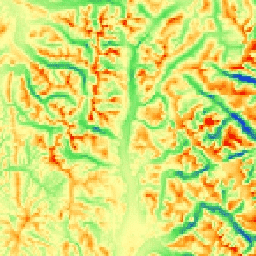
- ডেটাসেট উপলব্ধতা
- 2006-01-24T00:00:00Z-2011-05-13T00:00:00Z
- ডেটাসেট প্রদানকারী
- সংরক্ষণ বিজ্ঞান অংশীদার
- ট্যাগ
বর্ণনা
mTPI উপত্যকার ফর্ম থেকে রিজকে আলাদা করে। এটি একটি আশেপাশের মধ্যে গড় উচ্চতা দ্বারা বিয়োগ করা প্রতিটি অবস্থানের জন্য উচ্চতা ডেটা ব্যবহার করে গণনা করা হয়। mTPI ব্যাসার্ধের চলন্ত উইন্ডো ব্যবহার করে (কিমি): 115.8, 89.9, 35.5, 13.1, 5.6, 2.8 এবং 1.2। এটি JAXA-এর ALOS DEM-এর 30m "AVE" ব্যান্ডের উপর ভিত্তি করে (EE তে JAXA/ALOS/AW3D30_V1_1 হিসাবে উপলব্ধ)৷
কনজারভেশন সায়েন্স পার্টনারস (সিএসপি) পরিবেশগতভাবে প্রাসঙ্গিক জিওমরফোলজি (ইআরজিও) ডেটাসেট, ল্যান্ডফর্ম এবং ফিজিওগ্রাফিতে ল্যান্ডফর্ম এবং ফিজিওগ্রাফিক (ওরফে ল্যান্ড ফেসেট) প্যাটার্নের বিস্তারিত, বহু-স্কেল ডেটা রয়েছে। যদিও এই ডেটাগুলির অনেকগুলি সম্ভাব্য ব্যবহার রয়েছে, এই ডেটাগুলির মূল উদ্দেশ্য ছিল একটি পরিবেশগতভাবে প্রাসঙ্গিক শ্রেণীবিভাগ এবং ল্যান্ডফর্ম এবং ফিজিওগ্রাফিক ক্লাসগুলির মানচিত্র তৈরি করা যা জলবায়ু অভিযোজন পরিকল্পনার জন্য উপযুক্ত। কারণ ভবিষ্যত জলবায়ু পরিস্থিতির সাথে বড় অনিশ্চয়তা এবং পরিবেশগত প্রতিক্রিয়াগুলির চারপাশে আরও অনিশ্চয়তা রয়েছে, যা পরিবর্তনের সম্ভাবনা নেই সে সম্পর্কে তথ্য সরবরাহ করা পরিচালকদের শক্তিশালী জলবায়ু অভিযোজন পরিকল্পনা তৈরি করার জন্য একটি শক্তিশালী ভিত্তি সরবরাহ করে। ল্যান্ডস্কেপের এই বৈশিষ্ট্যগুলির পরিমাপ রেজোলিউশনের প্রতি সংবেদনশীল, তাই আমরা প্রদত্ত সূচকের ব্যাপ্তি এবং বৈশিষ্ট্যের ভিত্তিতে সর্বোচ্চ রেজোলিউশন প্রদান করি।
ব্যান্ড
পিক্সেল সাইজ
270 মিটার
ব্যান্ড
| নাম | ইউনিট | মিন | সর্বোচ্চ | পিক্সেল সাইজ | বর্ণনা |
|---|---|---|---|---|---|
AVE | মি | -3758* | 10963* | মিটার | ALOS-প্রাপ্ত mTPI নেতিবাচক (উপত্যকা) থেকে ধনাত্মক (শিরা) মান পর্যন্ত |
ব্যবহারের শর্তাবলী
ব্যবহারের শর্তাবলী
উদ্ধৃতি
Theobald, DM, Harrison-Atlas, D., Monahan, WB, & Albano, CM (2015)। জলবায়ু অভিযোজন পরিকল্পনার জন্য ল্যান্ডফর্ম এবং ফিজিওগ্রাফিক বৈচিত্র্যের পরিবেশগতভাবে প্রাসঙ্গিক মানচিত্র। PloS one, 10(12), e0143619
আর্থ ইঞ্জিন দিয়ে অন্বেষণ করুন
কোড এডিটর (জাভাস্ক্রিপ্ট)
var dataset = ee.Image('CSP/ERGo/1_0/Global/ALOS_mTPI'); var alosMtpi = dataset.select('AVE'); var alosMtpiVis = { min: -200.0, max: 200.0, palette: ['0b1eff', '4be450', 'fffca4', 'ffa011', 'ff0000'], }; Map.setCenter(-105.8636, 40.3439, 11); Map.addLayer(alosMtpi, alosMtpiVis, 'ALOS mTPI');
